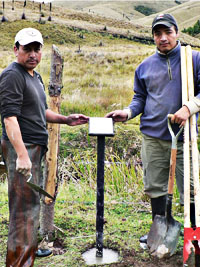First demarcation of Sangay National Park southern boundary
 |
|
Fundación Cordillera Tropical and park staff installed metal sign posts in cement bases every 250 to 500 meters along the boundary. |
|
Cuenca, Ecuador (14 December 2012) Fundación Cordillera Tropical and Ministry of Environment officials have demarcated the southern limit of Sangay National Park. The two institutions collaborated to install first-ever boundary markers and new signage in a 20 kilometer stretch of one of the park’s most densely populated regions. The park’s southern limit had previously been outlined on a map, but these efforts constitute its first field demarcation.
One of the goals of the delimitation is to increase public awareness about the park and its natural resources, as well as to engage local landowners in park conservation. Sangay National Park is the fourth largest park in Ecuador and covers nearly 502,000 hectares along the Andes’ Cordillera Oriental. The park’s forests and páramos harbor exceptional reserves of biodiversity, which are internationally recognized as part of the ¨Tropical Andes hotspot¨, an area whose extraordinary number of endemic species is highly threatened. The park’s southern region also captures and stores water used by the Paute-Integral complex, currently the country’s largest hydroelectric generation system. Despite its strategic national importance and international recognition, this is the first demarcation of the park’s southern boundary.
 |
|
New signage in nearby communities aims to increase knowledge about the park and its unique habitats. |
|
Similar to other tropical parks, an estimated 50% of lands in southern Sangay National Park are privately owned, with local landowners and indigenous communities holding legally recognized titles predating the park’s establishment. Currently private landowners conserve considerable stretches of forest.
¨Today, more than ever, we depend on the environmental services – water flow regulation and reduced siltation – provided by the forests and páramos on these private park lands,¨ notes Executive Director Catherine Schloegel. ¨We hope that this project establishes the foundation for a new model of park protection that incentivizes conservation on private land within and bordering protected areas. ¨
Fundación Cordillera Tropical led this collaborative effort between the Ministry of Environment -- Cañar Province Office and the National Office of Biodiversity, the Azogues County Municipal Government, and the Small Enterprise of ¨Park Guards for Nature Protection¨. This project has received generous support from the Fondo Ambiental Nacional, the Gordon and Betty Moore Foundation, Environmental Systems Research Institute (ESRI), and Ingeneria de Sistemas C. Ltda. (Ecuador).
